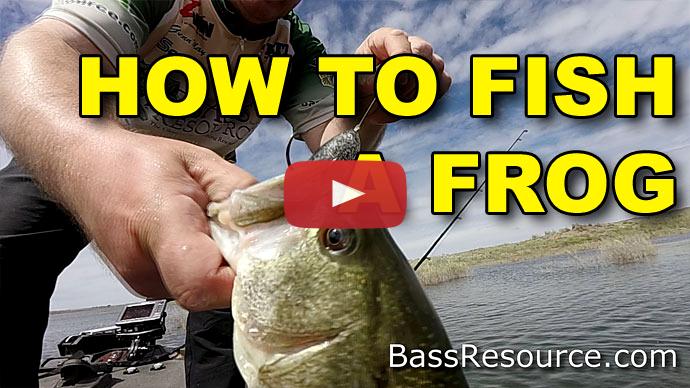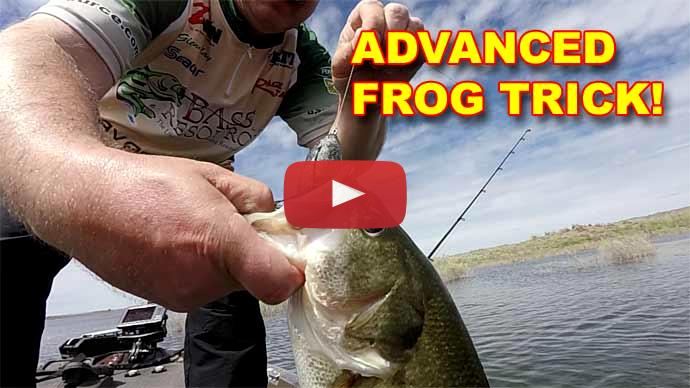Hey, everyone, bass pro, Dean Rojas here, and you're on bassresource.com. We're gonna talk about summertime, late spring, early fall frogging, and some of the things that I look for when I'm faced with different conditions, whether I'm on a river, a reservoir, you know, or just a local pond, if you will. So, some of the cool things about, you know, frogging this time of year, is when they bite it the best, when that water temperature starts creeping in, in the 60s and 70s and 80s, and then into the 90s in some parts of the country where, you know, you're dealing with thick, thick vegetation. So, I'm gonna go through a little bit about, you know, rod selection, gear ratio selection, and, obviously, bait selection for different times of, you know, different situations that you're faced with.
So, usually, when the water starts getting in the 60s and 70s, you get a lot of things that are reproducing at that point. And that, what I mean by that, it could be, you know, bluegill, it could be a shad spawn, it could be a crappie spawn, you know, or a bass spawn. There's a lot of life in the water at that point, and everything is shallow. Everything is like 5 feet or less. So anything swimming around in that realm is probably gonna get eaten, or get close to getting eaten, or chased, so that's where the frog fishing really starts to get moving. And it's one of my favorite times because especially if you're even around a shad spawn, you know, or they're eating fry or whatever it might be, a frog is an excellent way to get those fish to bite.
With so much vegetation in the water, you want something that's not gonna get hung up in the grass and even at that time or something that works, you know, naturally through the vegetation or the wood that you're fishing, where you don't get hung up. And we've designed the 65 Bronzeye and our Poppin' Frog to do all that to where you can throw it, skip it, cast it, however, you want to get it as close and as thick into the cover as you possibly can to get those bites that are hard to get to.
So, with that, the color selection that I like to use during that time of year, a lot of it has to do with the part of the country that I'm fishing in. But a lot of times that time of year, you wanna, they're obviously, they're keying on bait fish, amphibians, and so forth, so, like, you could use the whole color spectrum from, everywhere from a white to a black and everything in between. It could be yellow, purple, green, brown, gray, you know, red, whatever color you want it to be, you know, and create something and give it life to get those fish to come up and bite on it. And so I base a lot of the colors of the frogs on the water clarity that I'm fishing. And so obviously the clearer the water, the more of a clear iridescent color you wanna use that, that looks a lot like a minnow or something in the water that's fishing in and around the shallow area.
The darker the water, I tend to go to my darker colors, my browns, my grays, you know, and then I start blending in the black. But those are, like, for situations where the water's dingy, you know, you can see down maybe a foot, you know, sometimes less than that, sometimes two feet in that range. And then between that and then, like, the conditions overhead, if we have overcast or you have a thunderstorm coming in, or you have wind, you have any of those elements that defract a light, that those fish make 'em more aggressive and black is, anything with black in it or a dark object, they really seem to key in on that and really eat it good, not necessarily just blowing up on it or pushing it. I mean, they go to kill it and they go to eat it, and that's exactly what you want when you're frog fishing with that.
So, fishing the different types of cover, you know, it has to do with water clarity and water temperature. But, you know, the cadence that you wanna use when you're fishing in and around that, you wanna mix it up. And a lot of times you can key on, if you see bait fish in the area and how they're moving, if they're being scattered or they're moving around, you can use more of a frantic pace, stop it, and kill it, and move it around.
But that's the beauty of a frog, is you can actually watch how the cadence, what you're doing and be giving it life to get 'em to bite the bait. And then once they commit to it and on a certain cadence, they bite it, then you've unlocked it. Now you know exactly what to do, you just wanna duplicate that. And that's the way they want it, so that's the way you want to give it to 'em, is when they're, you know, chasing stuff, you want a frantic pace and slow it down if they're not. So it's just a deal where you can make the adjustments that you need on the water to capitalize on that.
Rod and reel selection is critical for me. I like a 7-foot, medium-heavy action because that time of the year I'm trying to make specific, you know, like, I wanna hit a little lily pad patch or a little grass mats. So it's just a matter of, you know, fishing maybe a 3 or 4-foot diameter and then pulling the frog out and hitting the next spot, 3 or 4 feet, you know, hitting the next spot, so it's all about target fishing.
But in the summertime, you know, we have these big mats, mats of, it can be eelgrass, milfoil, hydrilla, lily pads, whatever it is on the surface, dollar pads, alligator grass. There's so many different types of vegetation on the surface that it requires more of a heavier rod because you're fishing more in the cover as opposed to, like, target fishing, like I was just speaking of.
So there, you know, we designed a 7'4" heavy rod with a fast tip on it that allows you to make the cast and be able to work it on the surface of that mat of cheese, you know, slime, whatever it might be, wherever those fish are in. You wanna be able to, when they come up and grab the bait, set the hook and pull 'em out of there. As we all know, the first thing they wanna do is bury in the grass, so when that happens, you just wanna keep steady pressure on 'em. You don't wanna rip it out of there, you just wanna keep steady pressure and pull them out, you know, as best you can. But that heavier rod and the 80-pound FX2 Sunline Braid is not gonna break, so, you'll be fine with that.
So, gear ratio on the reels, 7 to 1 is probably my optimum. I would not use 8 to 1 on a matt type of presentation only because of the gearing. You know, I find it hard and difficult to gather up line as quickly and as efficiently as I would a 7 to 1, a 7 to 1 has a little more give to it than an 8 to 1 in heavy cover like that. If we're fishing open water, I would say, "No, 8 to 1 every time." But when you're fishing that stuff where you've gotta winch 'em out of there, a 7 to 1's a little more forgiving than the 8 to 1 on that. So, personal choice, you know, if you like the 8 to 1, that's fine too. It really doesn't matter as long as you're frogging, that's all that matters and you're having fun with it.
So, you know, in the summertime it's a lot of fun and, you know, we're talking about windows on when they bite the frog. Obviously, like days like today, you know, they're gonna be up under, underneath something. So you can see the lily pads behind me, patches of grass, they're gonna be in that cover as thick as you can, so you wanna be looking for those type of clumps, you know, of grass. And that's where the target, you know, way of casting is you can hit multiple clumps without having to work a big open spans of grass because those are the percentages of...that's where they're gonna be, is where there's the most shade and where they can ambush the prey.
So you gotta physically, you know, visualize it, you know, in the water, you know where they're gonna be at, and then, you know, make those presentations. If it doesn't work, you gotta try something else as well. But water temperature, anywhere from, you know, 65 all the way to 90 degrees, they can be, you know, in a foot of water up there on the bank, or they could be out here in 3 feet of water on the clumps. It's just, it's up to you on where you wanna fish and figuring out where they're at. And once you've figured 'em out, then it's just a matter of duplicating that elsewhere in the area or throughout the whole lake itself.
So, you know, it's an awesome way to fish. It's a fun way to fish, especially when you're out there with your buddies having a good time. The explosions are awesome. Yeah, but thank you for tuning in to BassResource.com. That's my, you know, summertime, you know, frogging techniques, and go out there and have a good time frogging.


